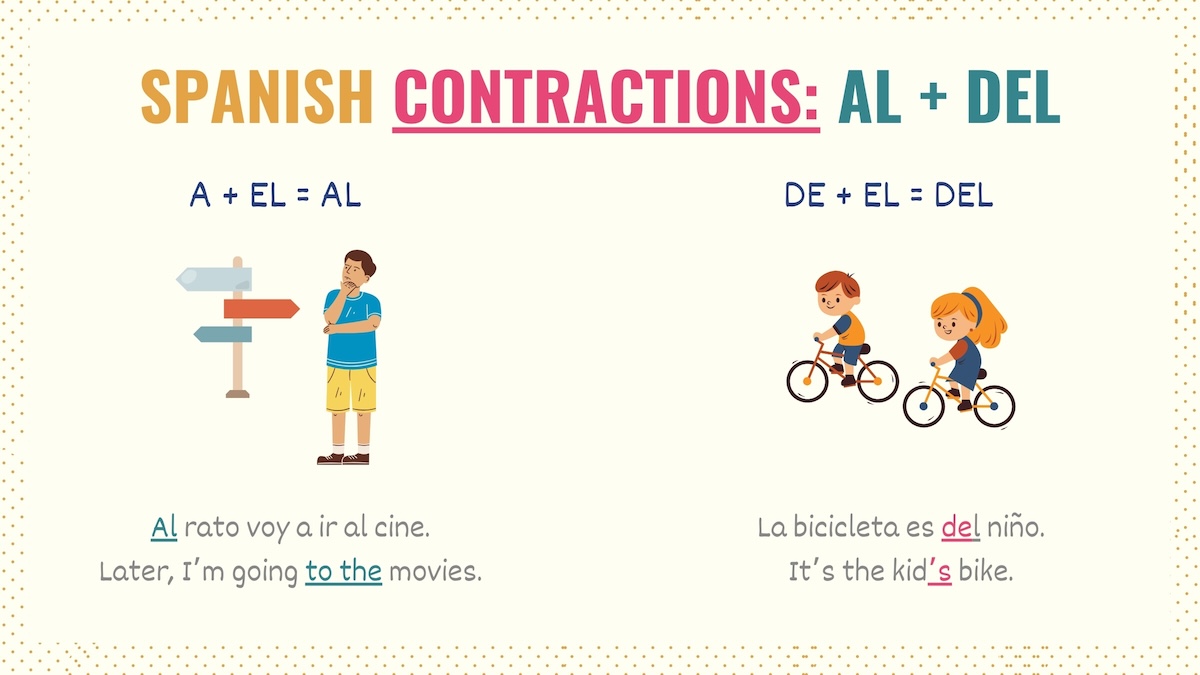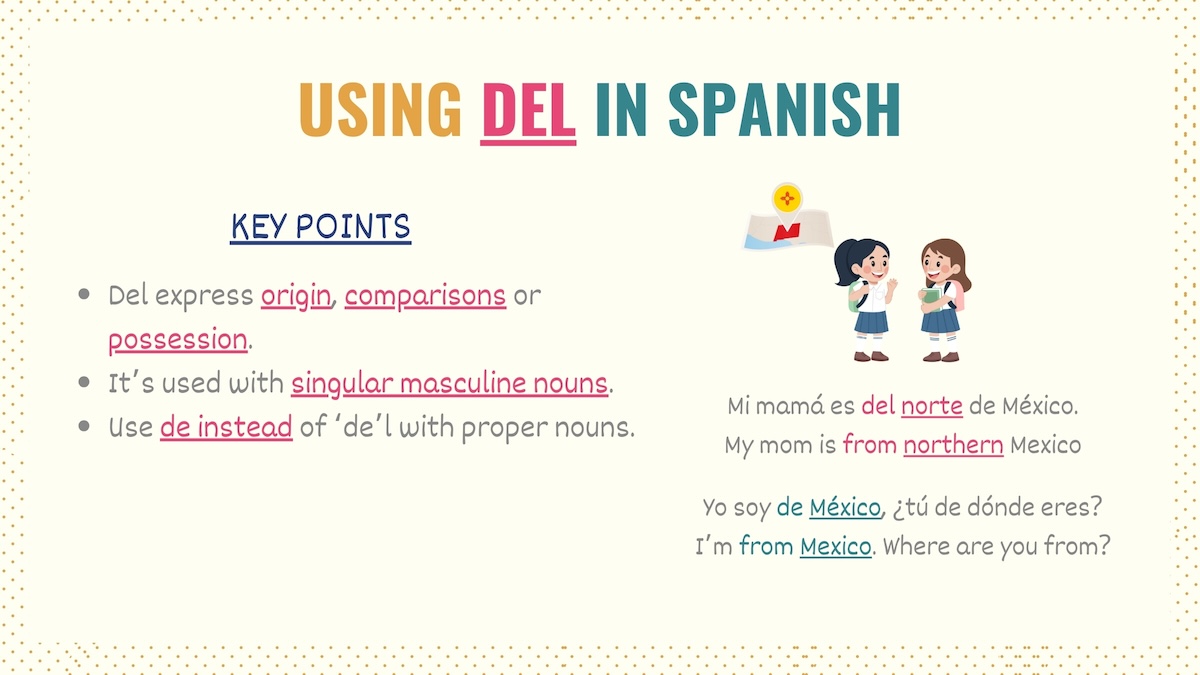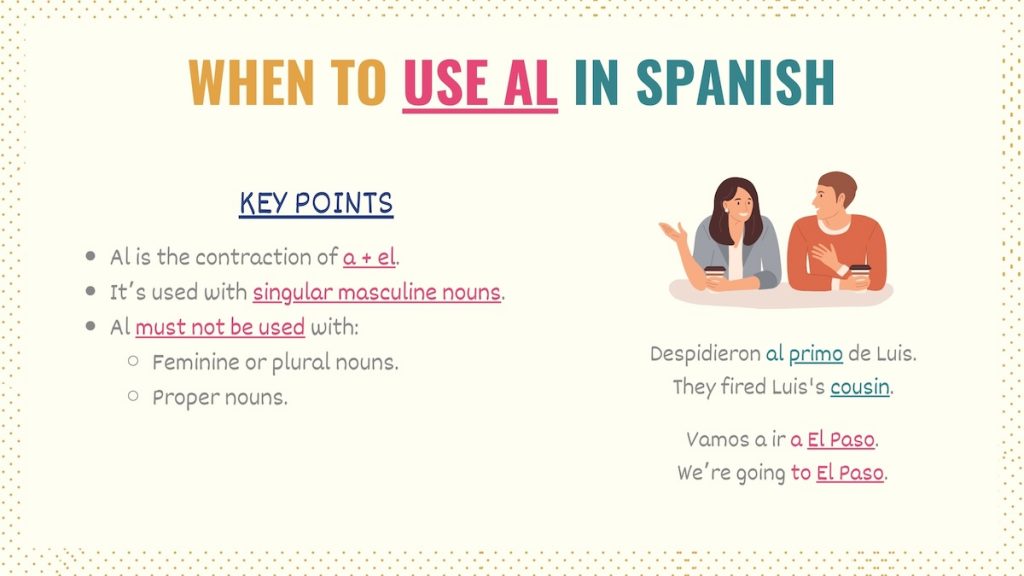Del and al are contractions in Spanish that must be used with singular masculine nouns. Al is the contraction of the preposition a + el, whereas del is the contraction of the preposition de + el.

These contractions have a few elements in common – the definite article el and the fact that they can only work with singular masculine nouns. But since they’re formed with unique Spanish prepositions, their applications differ.
Check these examples:
Ese libro es del vecino. Ponlo al lado de la tele.
That’s the neighbor’s book. Put it next to the TV.
Clara se fue del banco a las cuatro para ir al dentista.
Clara left the bank at four to go to the dentist.
Spanish Contractions Key Points
Al and del are the only two contractions in Spanish, and they’re crucial for communication. Here are some key points to keep in mind:
- Both al and del contract with the article el. As a result, they work with singular masculine nouns.
- A + el = al.
- De + el = del.
- Al expresses direction, destination, location, time, or introduces the object in a sentence.
- Del indicates origin and possession. It can also be used in comparative sentences.
- The prepositions a and de must be used instead of the contractions with:
- Proper nouns: “de Mexico” or “a El Paso, Texas”.
- Feminine or plural nouns: “es de los niños”, “voy a la tienda”.
- Singular masculine nouns preceded by Spanish determiners other than ‘el’: “es de mi hijo”.
When to Use Del in Spanish
Del in Spanish (de + el) is used in sentences that express origin, comparisons or possession, as long as these statements are formed with singular masculine nouns:
Del + [singular masculine noun]
Mi mamá es del norte de México.
My mom is from northern Mexico.
La hija del profesor es doctora.
The professor‘s daughter is a doctor.
Esas galletas son del niño de rojo.
Those cookies are the kid’s in red.
Saúl es el más rápido del equipo.
Saúl is the fastest in the team.
No creo que la leche sirva, es del quince de marzo.
I don’t think the milk is good; it’s from March fifteen.
De vs del
The Spanish contraction del is not used with feminine or plural nouns. With these elements, you must use the preposition de and the appropriate article.
De + [feminine/plural article] + [feminine/plural noun]
El hijo de la profesora tiene 5 años.
The teacher‘s son is 5 years old.
Esas galletas son de los niños.
Those cookies are the kids’ cookies.
When it comes to singular masculine nouns, de must also be used instead of del if working with proper Spanish nouns or if a common noun is preceded by other determiners, such as possessive or demonstrative adjectives.
Check these examples:
De + (determiner) + [noun]
Yo soy de México, ¿tú de dónde eres?
I’m from Mexico. Where are you from?
El celular de mi mamá está en la mesa.
My mom‘s cell phone is on the table.
¿Cuál es la serie más vista de este mes?
What’s the most watched TV show this month?

How & When to Use Al in Spanish
Al in Spanish is the contraction of a + el, and it’s also used with singular masculine nouns. Because of the nature of the preposition a, these nouns are often used to express:
- Direction/Destination
- Location
- Time
- Direct and indirect objects
Here are some examples:
Al + [singular masculine noun]
Despidieron al primo de Luis.
They fired Luis’s cousin.
¿Quieres ir al cine mañana?
Do you want to go to the movies tomorrow?
Dejé mis llaves junto al teléfono de Tina.
I left my keys next to Tina’s phone.
Al rato voy a llevar al perro al veterinario.
Later, I’m going to take the dog to the vet.
Similar to del, the contraction al in Spanish must not be used with:
- Feminine or plural nouns preceded by articles.
- Proper nouns.
- Singular masculine nouns preceded by other determiners, such as possessives.
You can see these rules in the following examples:
A + (determiner) + [noun]
Vamos a ir a El Paso.
We’re going to El Paso.
¿Puedes llevar a las niñas a la tienda?
Can you take the girls to the store?
Juan le regaló un dulce a Luis.
Juan gave a candy to Luis.
Ven a este banco y de aquí nos vamos al cine.
Come to this bank and from here we’ll go to the movies.
Take Note: Using the preposition a to introduce the object of a sentence is known as personal a in Spanish. If that object is direct, you will not see this structure in English.


